Abstract
OBJECTIVES--To assess neurobehavioural effects of low exposure to lead, 43 workers from a lead smelter and 45 workers from a glass factory were evaluated with the World Health Organisation neurobehavioural core test battery (NCTB) in a cross sectional study. METHODS--The NCTB comprises a questionnaire and seven tests that measure simple reaction time, short-term memory (digit span, Benton), mood (profile of mood states), eye-hand coordination (Santa Ana pegboard, pursuit aiming II), and perceptual speed (digit-symbol). RESULTS--Smelter workers were employed on average for four years, and had a mean blood lead concentration of 2.0 mumol/l (42 micrograms/dl). Glass factory workers had a mean of 0.72 mumol/l (15 micrograms/dl). Historical blood lead concentrations were used to classify exposure based on current, peak, and time weighted average. Although the exposed workers performed less well than the non-exposed in 10 of 14 response variables, only profile of mood states tension-anxiety, hostility, and depression mood scales showed a significantly poorer dose-response relation with blood lead concentration in multiple linear regression models that included age, education, and alcohol intake as covariates. The frequency of symptoms of anger, depression, fatigue, and joint pain were also significantly increased in the exposed group. CONCLUSION--This study is consistent with the larger body of neurobehavioural research of low occupational exposure to lead. The small effects found in this study occurred at blood lead concentrations slightly lower than those reported in several previous studies.
Full text
PDF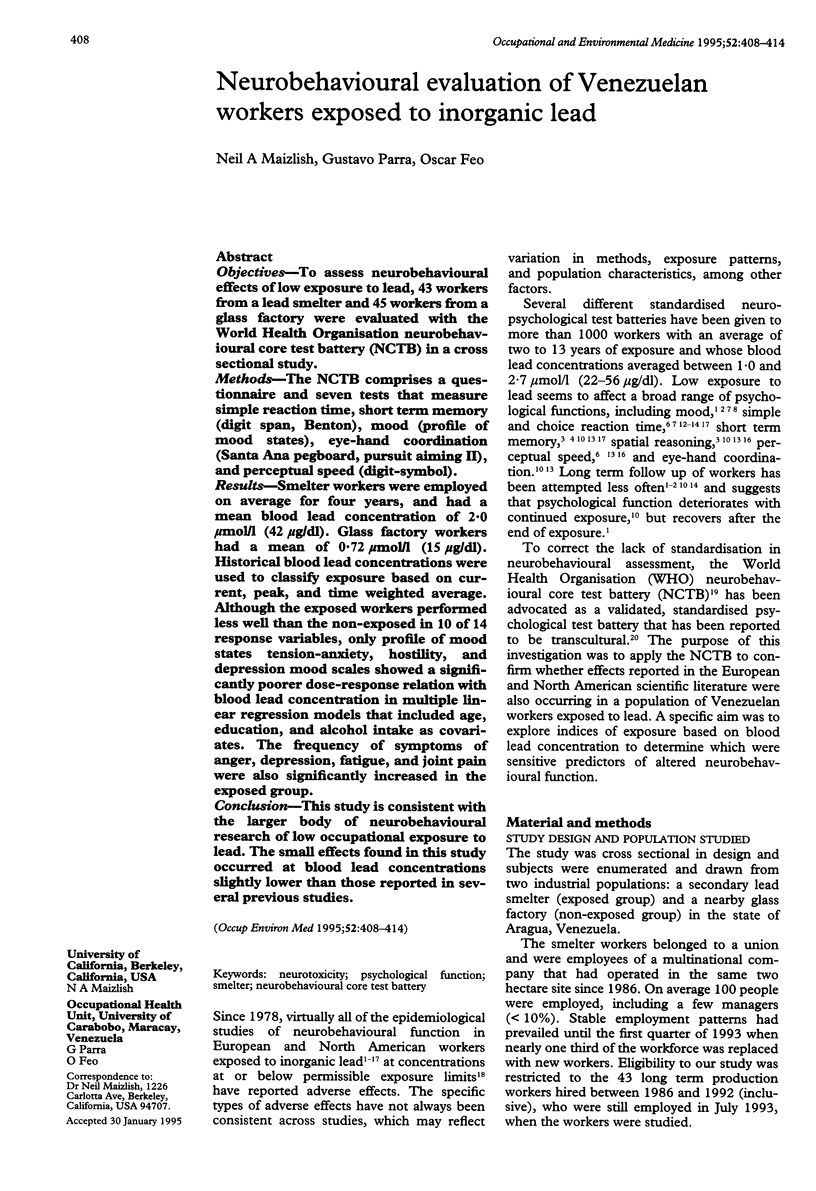
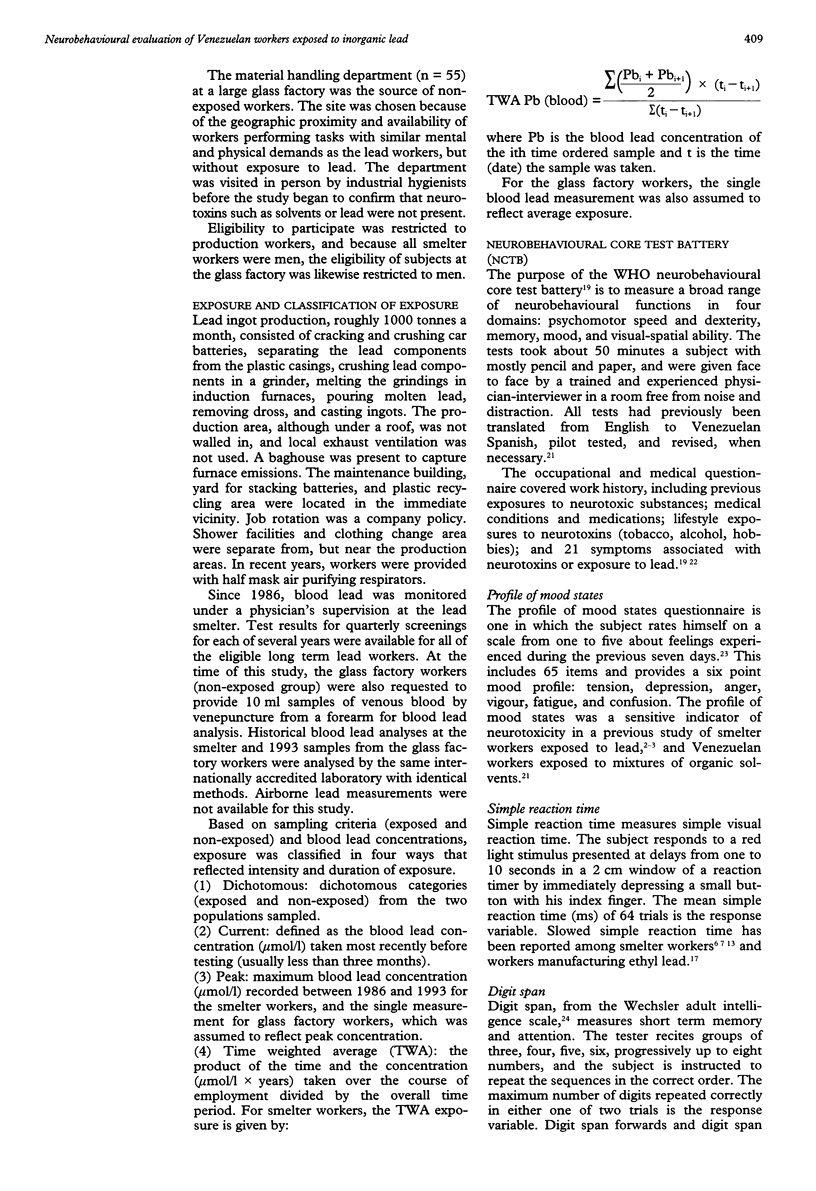
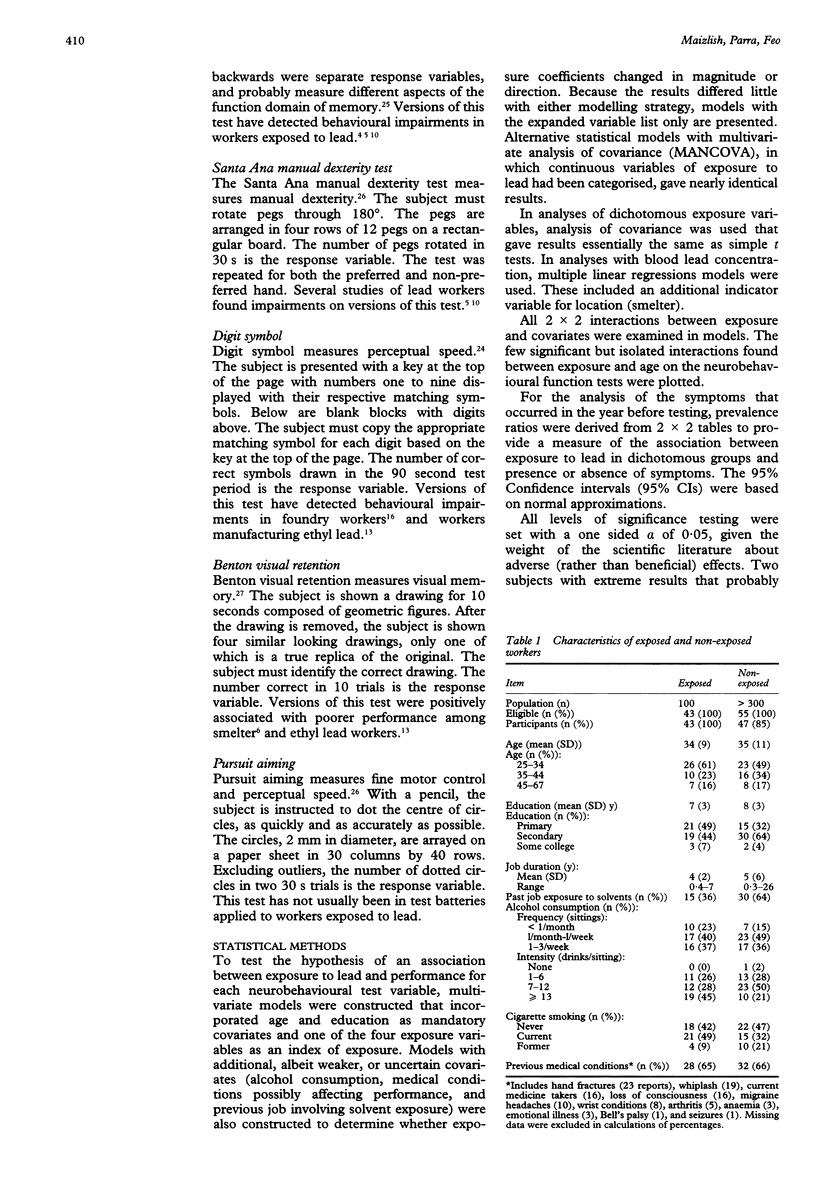
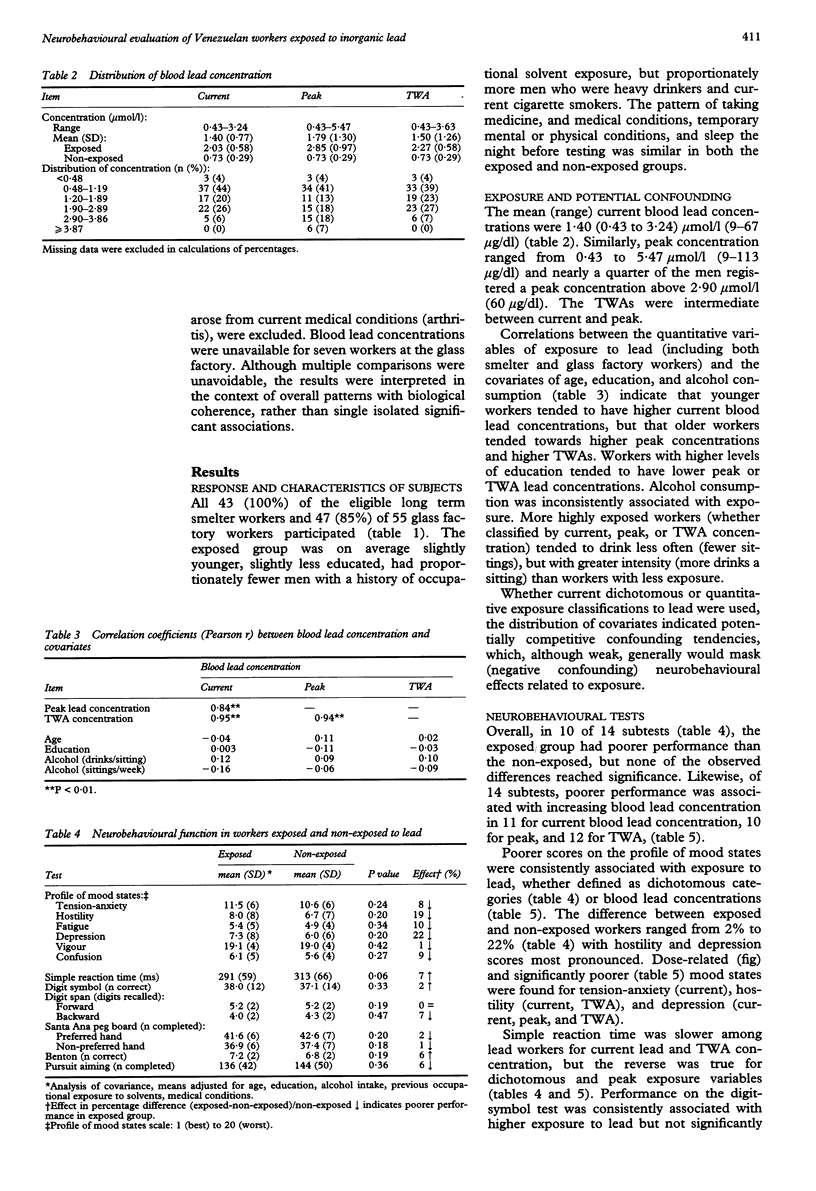
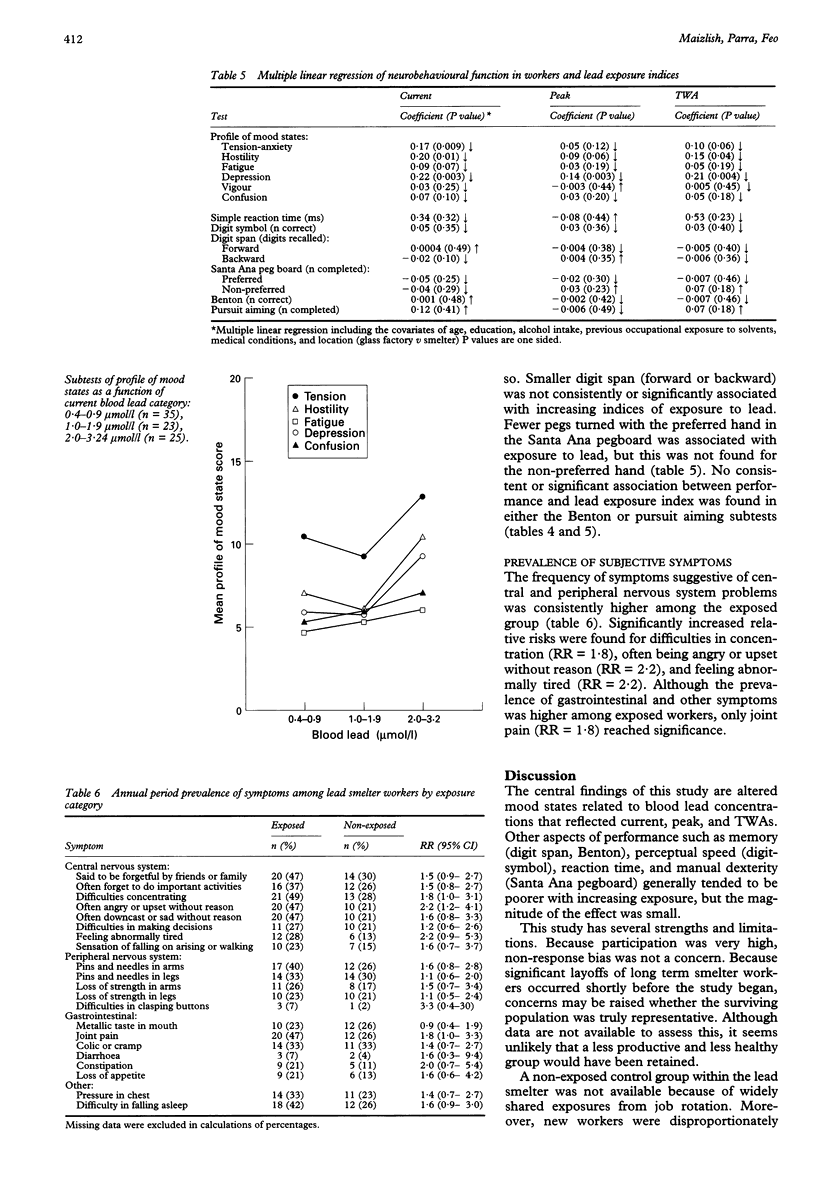
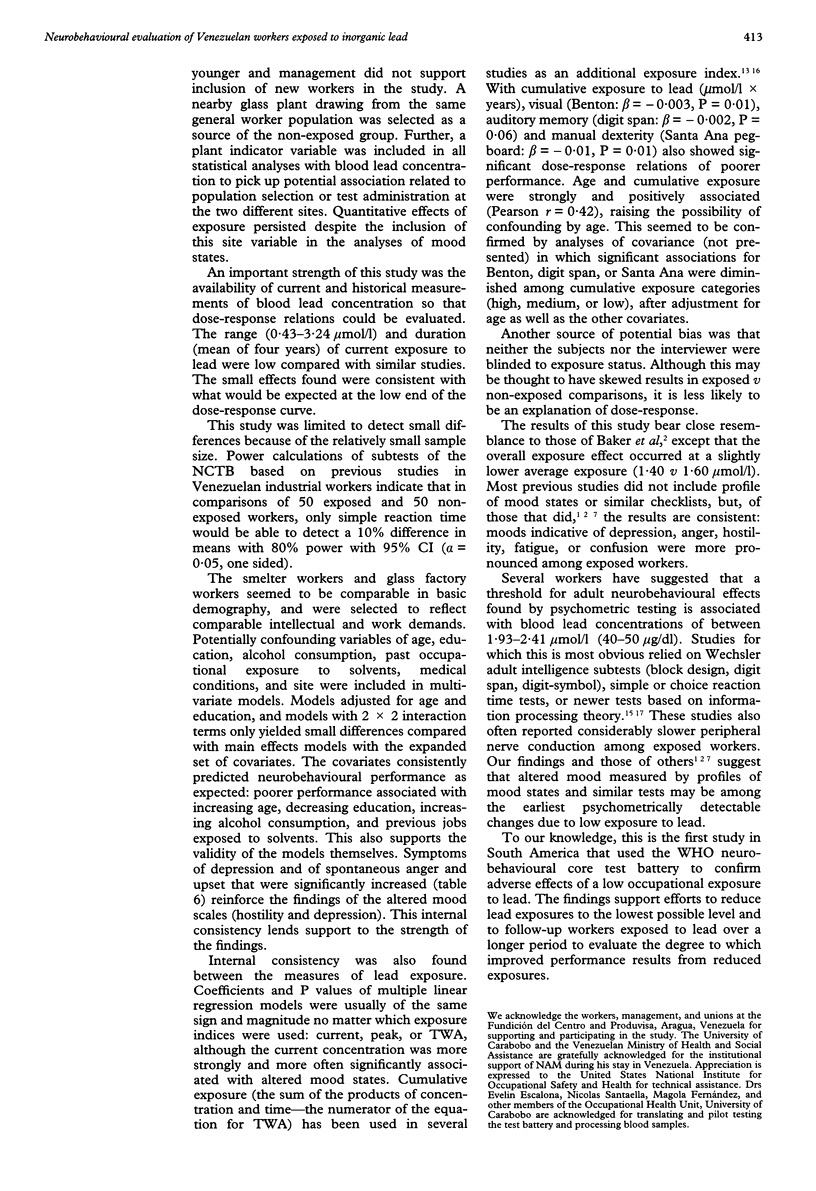
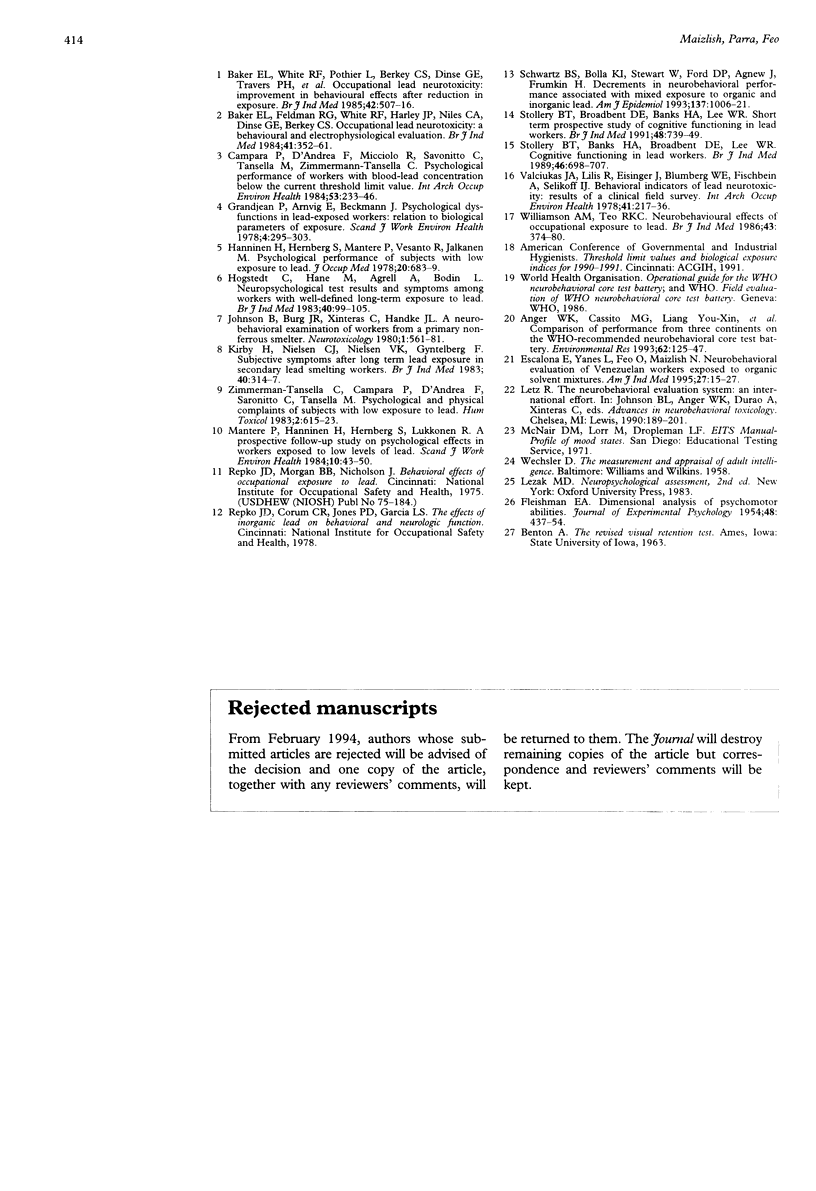
Selected References
These references are in PubMed. This may not be the complete list of references from this article.
- Anger W. K., Cassitto M. G., Liang Y. X., Amador R., Hooisma J., Chrislip D. W., Mergler D., Keifer M., Hörtnagl J., Fournier L. Comparison of performance from three continents on the WHO-Recommended Neurobehavioral Core Test Battery. Environ Res. 1993 Jul;62(1):125–147. doi: 10.1006/enrs.1993.1097. [DOI] [PubMed] [Google Scholar]
- Baker E. L., Feldman R. G., White R. A., Harley J. P., Niles C. A., Dinse G. E., Berkey C. S. Occupational lead neurotoxicity: a behavioural and electrophysiological evaluation. Study design and year one results. Br J Ind Med. 1984 Aug;41(3):352–361. doi: 10.1136/oem.41.3.352. [DOI] [PMC free article] [PubMed] [Google Scholar]
- Baker E. L., White R. F., Pothier L. J., Berkey C. S., Dinse G. E., Travers P. H., Harley J. P., Feldman R. G. Occupational lead neurotoxicity: improvement in behavioural effects after reduction of exposure. Br J Ind Med. 1985 Aug;42(8):507–516. doi: 10.1136/oem.42.8.507. [DOI] [PMC free article] [PubMed] [Google Scholar]
- Campara P., D'Andrea F., Micciolo R., Savonitto C., Tansella M., Zimmermann-Tansella C. Psychological performance of workers with blood-lead concentration below the current threshold limit value. Int Arch Occup Environ Health. 1984;53(3):233–246. doi: 10.1007/BF00398816. [DOI] [PubMed] [Google Scholar]
- Escalona E., Yanes L., Feo O., Maizlish N. Neurobehavioral evaluation of Venezuelan workers exposed to organic solvent mixtures. Am J Ind Med. 1995 Jan;27(1):15–27. doi: 10.1002/ajim.4700270103. [DOI] [PubMed] [Google Scholar]
- FLEISHMAN E. A. Dimensional analysis of psychomotor abilities. J Exp Psychol. 1954 Dec;48(6):437–454. doi: 10.1037/h0058244. [DOI] [PubMed] [Google Scholar]
- Grandjean P., Arnvig E., Beckmann J. Psychological dysfunctions in lead-exposed workers. Relation to biological parameters of exposure. Scand J Work Environ Health. 1978 Dec;4(4):295–303. doi: 10.5271/sjweh.2696. [DOI] [PubMed] [Google Scholar]
- Haenninen H., Hernberg S., Mantere P., Vesanto R., Jalkanen M. Psychological performance of subjects with low exposure to lead. J Occup Med. 1978 Oct;20(10):683–689. [PubMed] [Google Scholar]
- Hogstedt C., Hane M., Agrell A., Bodin L. Neuropsychological test results and symptoms among workers with well-defined long-term exposure to lead. Br J Ind Med. 1983 Feb;40(1):99–105. doi: 10.1136/oem.40.1.99. [DOI] [PMC free article] [PubMed] [Google Scholar]
- Kirkby H., Nielsen C. J., Nielsen V. K., Gyntelberg F. Subjective symptoms after long term lead exposure in secondary lead smelting workers. Br J Ind Med. 1983 Aug;40(3):314–317. doi: 10.1136/oem.40.3.314. [DOI] [PMC free article] [PubMed] [Google Scholar]
- Mantere P., Hänninen H., Hernberg S., Luukkonen R. A prospective follow-up study on psychological effects in workers exposed to low levels of lead. Scand J Work Environ Health. 1984 Feb;10(1):43–50. doi: 10.5271/sjweh.2364. [DOI] [PubMed] [Google Scholar]
- Schwartz B. S., Bolla K. I., Stewart W., Ford D. P., Agnew J., Frumkin H. Decrements in neurobehavioral performance associated with mixed exposure to organic and inorganic lead. Am J Epidemiol. 1993 May 1;137(9):1006–1021. doi: 10.1093/oxfordjournals.aje.a116757. [DOI] [PubMed] [Google Scholar]
- Stollery B. T., Banks H. A., Broadbent D. E., Lee W. R. Cognitive functioning in lead workers. Br J Ind Med. 1989 Oct;46(10):698–707. doi: 10.1136/oem.46.10.698. [DOI] [PMC free article] [PubMed] [Google Scholar]
- Stollery B. T., Broadbent D. E., Banks H. A., Lee W. R. Short term prospective study of cognitive functioning in lead workers. Br J Ind Med. 1991 Nov;48(11):739–749. doi: 10.1136/oem.48.11.739. [DOI] [PMC free article] [PubMed] [Google Scholar]
- Valciukas J. A., Lilis R., Eisinger J., Blumberg W. E., Fischbein A., Selikoff I. J. Behavioral indicators of lead neurotoxicity: results of a clinical field survey. Int Arch Occup Environ Health. 1978 Jul 14;41(4):217–236. doi: 10.1007/BF00378753. [DOI] [PubMed] [Google Scholar]
- Williamson A. M., Teo R. K. Neurobehavioural effects of occupational exposure to lead. Br J Ind Med. 1986 Jun;43(6):374–380. doi: 10.1136/oem.43.6.374. [DOI] [PMC free article] [PubMed] [Google Scholar]
- Zimmermann-Tansella C., Campara P., D'Andrea F., Savonitto C., Tansella M. Psychological and physical complaints of subjects with low exposure to lead. Hum Toxicol. 1983 Oct;2(4):615–623. doi: 10.1177/096032718300200406. [DOI] [PubMed] [Google Scholar]


